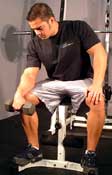November 27, 2023
Tennis Elbow / Golfers Elbow
Tennis elbow (Lateral Epicondylitis) is a common condition which causes pain on the outside or lateral aspect of the elbow.
Golfers elbow (Medial Epicondylitis) is a common condition which causes pain on the inside or medial aspect of the elbow.
The condition involves acute or chronic inflammation of the tendons that join the forearm muscles on to the elbow. It can be caused by acute trauma to the site or brought on by longer term overuse and is termed lateral or medial epicondylitis. This condition often infers an inability for the supporting muscles to absorb the loading around the elbow..
Symptoms
Epicondylitis can cause pain that travels through the elbow to the forearm and wrist, which then affects the gripping and lifting capability. There can be elbow tenderness, inflammation, weakness of the forearm and difficulty holding heavy items in the hand.
Stiffness and difficulty completing simple tasks, such as opening a door handle, turning a tap or shaking hands can also be signs of inflammation.
Common Causes
Epicondylitis is often caused by overuse and the repeated contraction of the forearm muscles that are used to straighten and raise the hand and wrist. Repeated motions and stress to the tendon tissue may create a series of tiny tears in the tendons on the outer elbow.
The condition can also occur as a result of overexertion, incorrect heavy lifting technique, a direct blow to the elbow, a sudden powerful pull or forceful extension. Inflammation in the form of tendinitis can begin long before pain is felt, and can take days, weeks or months to totally disappear.
People with Epicondylitis should use stretching and strengthening routines to try to manage and reduce the symptoms.
Firstly, a thorough and correct warm up will help to prepare the muscles and tendons for any activity to come. Without a proper warm up there would be limited beneficial warm blood flowing to the forearm area.
See https://fitsmart.com.au/exercise/exercise-and-warm-ups/
1. Breathe faster. eg. A light cycle. This helps move warm blood into the muscles.
2. Warm up the direct area
Before any activity be sure to thoroughly warm up the specific muscles that will be used during your sport or activity with light loadings eg. light weights, elasto bands, slow movements.
Secondly, strengthening and conditioning the muscles of the upper arm, forearm and wrist will also help to prevent overloading and inflammation. Note that there should be a re-assessment of any existing gym routine, sport, work or lifestyle that may have contributed towards the over loading and inflammation.
 Wrist Flexor
Wrist Flexor  Wrist Extensor
Wrist Extensor
Thirdly it is important to undertake a structured stretching routine.
There are a number of specific stretches you can do for your flexors and extensor forearm muscles.
When muscles and tendons are flexible and supple, they are able to move and perform without being over stretched and over loaded.


